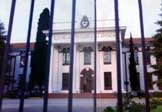Inside an Argentine death camp
At least 5,000 were killed in School of Naval Mechanics camp during the bloody military rule that slaughtered the South American country from 1976 to 1983
Figures overwhelm: in this 34-building complex of 17 hectares situated in the heart of Buenos Aires, at least 5,000 were psychologically and physically tortured to later find a certain death after being thrown narcotized to the River Plate in the notorious “death flights”. The School of Naval Mechanics, or ESMA, is a symbol of the horror that reigned during the military rule that slaughtered Argentina from 1976 to 1983, a standing monument to an era of darkness that begun exactly 29 years ago.
The ESMA was ceded to the Navy by civil authorities in 1924 to hold the National Naval School and some other instruction centers for the new generations of high-classed well educated officers. But when in 1946 Gen. Peron jumped to power backed by millions of poor workers and farmers, this aristocratic elite of British oriented naval officers pledged to crackdown some day on the rising masses.
They saw the chance in 1976, when a military coup toppled the embattled government of Maria Estela Martinez, the widow of Peron, who had died in the Presidency less than two years ago. Since then, the ESMA became one of Latin America's bloodiest death camps where the Argentine Navy tortured and killed more people than Chile's dictatorship in 17 years.
The main building of the ESMA, where sadistically Navy officers shared their lives with thousands of tortured opponents, is now empty. The Navy was ordered to cede it to civil authorities last year and the government agreed to build there a memorial handled by human right groups and survivors associations.
Living and working in the ESMA
Enrique Mario Fukman, an ESMA survivor, guides visitors. “It is only open for restricted groups”, he explains. “We won't open to the public until they do not withdraw completely from the whole place”. 27 out of the 34 buildings are still in possession of the Navy. To avoid incidents, authorities have installed a white fence to separate both sectors.
“They brought me in through this gate”, tells Fukman to PRAVDA.Ru pointing out at a brown metal door that leads to a dark hall. “Here we suffered our first tortures. Navy officers covered our heads with plastic bags as tied our hands and feet with chains”, he explains. Through the same door, prisoners were taken out in groups of 21 each Wednesday night to the local domestic airport to take the “death flights”.
“I was kidnapped in November 1978 and released in February 1980”, tells Fukman, who is one of the only 200 survivors of the camp. “I was a Montonero and they kidnapped me after a meeting with my group. They tortured me for 15 months to obtain some information about the others”.
Upstairs is the main hall of the building, where Navy officers spent their free time playing cards, drinking and chatting. Prisoners were conducted to the first and the second floor where officers had their bedrooms and crossing a wooden door, prisoners had their torture rooms.
“Here, in the same floor, officers rested as prisoners were tortured and often died”, explains Mr. Fukman. PRAVDA.Ru asks why such a sadistic attitude: “It was politically motivated. Navy commanders want all the admiralty to be involved in the repression”.
“Here we used to sleep”, says Fukman as walks into a now empty hall. Prisoners had to lie in an 80 centimetres wide box with their head covered for days, weeks, and even months. To go to the restrooms, they had to ask permission to the guards. “We know that we would be beaten and women raped each time we went” remembers Fukman.
“At the bottom of the hall there was an office where we work for the Navy as slaves”, says, Carlos Garcia, another ESMA survivor. There, selected prisoners prepared press reports for the Navy commanders and produced false documentation for their illegal operations abroad. “False Argentine, Spanish and Uruguayan passports were printed, as well as false Chilean currency ahead of 1978 imminent military clash”, adds Fukman.
As in a nightmare, images of the tortured come to the minds of the visitors. The special room for the pregnant women is still there. One can imagine troopers raping them and Mengele-doctors depriving them from their babies after giving birth. Children were also tortured to death.
Fukman remembers something very appropriate: Ricardo Cavallo, one of the worst killers had his office next to the tortures room. In the wall he had a picture with a statement from a certain French commander in Algeria. It reads: “If an Army aims to defeat the people it has to be ready to get deeply into shit”. The Argentine Navy committed the most horrendous atrocities against its people, and it did it.
On the photo: The façade of the ESMA. The death camp will be converted into a memorial as soon as the Navy fully withdraws later this year.
Subscribe to Pravda.Ru Telegram channel, Facebook, RSS!




